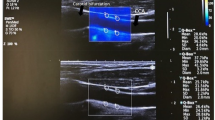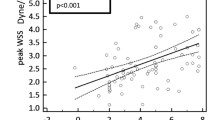Abstract
The aim of our study was to evaluate the effect of the intravenous contrast media iomeprol on wall shear stress, blood flow and vascular parameters in the common carotid and brachial artery. Thirty outpatients undergoing thoracic or abdominal spiral CT scans were studied. The internal diameter and flow velocity of the common carotid and brachial artery were evaluated by ultrasound, and blood viscosity was measured before and after low osmolality iomeprol (Iomeron 350) injection. The wall shear stress, blood flow and pulsatility index were calculated. To test the differences between groups, the Wilcoxon rank test and Mann Whitney U test were applied. Blood viscosity decreased slightly, but significantly after contrast media (4.6±0.7 vs. 4.5±0.7 mPa.s, P=0.02). Contrarily, blood flow and wall shear stress did not change in the common carotid artery, but significantly decreased in the brachial artery (0.9±0.4 vs. 0.6±0.3 ml/s, P<0.0001, and 41.5±13.9 vs. 35.3±11.0 dynes/cm2, P<0.002, respectively), whereas the pulsatility index significantly increased in the brachial artery (5.0±3.3 vs. 7.5±5.3, P<0.001). Iomeprol injection causes blood flow and wall shear stress reduction of the brachial artery; the rise in the pulsatility index suggests an increase in peripheral vascular resistance. Further investigation is needed to evaluate whether these modifications can be clinically relevant.


Similar content being viewed by others
References
Baile EM, Parè PD, D’yachkova Y, Carere RG (1999) Effects of contrast media on coronary vascular resistances. Chest 116:1039–1045
Pugh ND, Karlsson JOG (1997) Vasodilator and hemorheological effects of iodinated contrast media. Drugs of Today 33:191–203
Morcos SK, Dawson P, Pearson JD, Jeremy JY, Davenport AP, Yates MS, Cipolla TP, de Haen C, Muschick P, Krause W, Refsum H, Emery CJ, Liss Nygren A, Haylor J, Pugh ND, Karlsson JO (1998) The haemodynamic effects of iodinate water soluble radiographic contrast media: a review. Eur J Radiol 29:31–46
Limbruno U, Caterina RD (2003) Vasomotor effects of iodinate contrast media: just side effect? Curr Vasc Pharmacol 1:321–328
Strickland NH, Rampling MW, Dawson P, Martin G (1992) Contrast media-induced effects on blood rheology and their importance in angiography. Clin Radiol 45:240–242
Krystal GJ, Salem MR (1996) Investigations into the mechanisms of coronary vasodilation. Invest Radiol 31:556–562
Lloyd DA, Stein JS, Rowe MI (1990) The effects of a hyperosmolar intravenous contrast medium on blood viscosity. Investig Radiol 26:220–223
Gustavsson CG, Persson SU, Larsson H, Persson S, Thorvinger BOS (1996) Vein blood rheology alterations immediately after coronary angiography with iohexol, and one month later. Clin Hemorheol 16:737–743
Aliev G, Obrenovich ME, Seyidova D, Rzayev NM, Aliyev AS, Raina Ak, Lamanna JC, Smith MA, Perry G (2003) X-Ray contrast media induce aortic endothelial damage, which can be prevented with prior heparin treatment. J Submicrosc Cytol Pathol 35:253–266
Karstoft J, Baath L, Jansen I, Edvinsson L (1995) Contrast medium-induced vasoconstriction. An investigation of the vasoconstrictive action of iohexol in isolated rabbit coronary arteries. Acta Radiol 36:198–203
Olroyd S, Haylor JL, Morcos SK (1995) Bosentan, an orally active endothelin antagonist: effect on renal response to contrast media. Radiology 196:661–665
Morkos SK, Olroyd S, Haylor JL (1997) Effect of radiographic contrast media on endothelium derived nitric oxide-dependent renal vasodilatation. Br J Radiol 70:154–159
Liss P, Nygren A, Olsson U, Ulfendahl HR, Erikson U (1996) Effect of contrast media and mannitol on renal medullary blood flow and red cell aggregation in the rat kidney. Kidney Int 49:1268–1275
Gnasso A, Carallo C, Irace C, Spagnuolo V, De Novara G, Mattioli PL, Pujia A (1996) Association between intima-media thickness and wall shear stress in the common carotid arteries in healthy male subjects. Circulation 94:3257–3262
Sorensen KE, Celermajer DS, Spiegelharter DJ, Georgakopoulos D, Robinson J, Thomas O et al (1995) Non-invasive measurement of human endothelium dependent arterial responses: accuracy and reproducibility. Br Heart J 74:247–253
Verma S, Buchanan M, Anderson TJ (2003) Endothelial function testing as a biomarker of vascular disease. Circulation 108:2054–2059
Lo Russo V, Taroni P, Alvino S, Spinazzi A (2001) Pharmacokinetics and safety of iomeprol in healthy volunteers and in patients with renal impairment or end-stage renal disease requiring hemodialysis. Investig Radiol 36:309–316
Limbruno U, Petronio AS, Amoroso G, Baglini R, Paterni G, Merelli A, Mariottti R, De Caterina R, Mariani M (2000) The impact of coronary artery disease on the coronary vasomotor response to nonionic contrast media. Circulation 101:491–497
Wellnhofer E, Dreysse S, Fleck E (2001) Is contrast-related vasodilatation after intracoronary iodixanolo and iopromide in vivo endothelium dependent? Eur J Echocardiogr 2:285–291
Pugh ND, Hutcheson IR, Edwards DH, Nossen JO, Karlsson JO, Griffith TM (1995) Angiographic contrast media relax isolated rabbit aorta through an endothelium-independent mechanism that may not depend on the presence of the iodine atom. Br J Radiol 68:23–26
Hutcheson IR, Griffith TM, Pitman MR, Towart R, Gregersen M, Refsum H et al (1999) Iodinate radiographic contrast media inhibit shear stress and agonist evoked release of NO by the endothelium. Br J Pharmacol 128:451–457
Ishizaka H, Kuo L (1997) Endothelial ATP-sensitive potassium channels mediate coronary microvascular dilation to hyperosmolarity. Am J Physiol 273:H104–H112
Bagnis DG, Jacquiaud C, Dubois M, Adabra Y, Jaudon C (1999) Renal effects of low and isoosmolar contrast media on renal hemodynamic in a normal and ischemic dog kidney. Invest Radiol 34:1–4
Liss P, Carlsson PO, Palm F, Hansell P (2003) Et-A receptor antagonist BQ123 prevents radiocontrast media-induced renal medullary hypoxia. Acta Radiol l44:111–117
Hetzel GR, May P, Hollenbeck M, Voiculescu A, Modder U, Grabensee B (2001) Assessment of radiocontrast media induced renal vasoconstriction by color coded duplex sonography. Ren Fail 23:77–83
Toda N, Okamura T (1992) Regulation by nitroxidergic nerve of arterial tone. Int Union Physiol Sci 7:148–156
Brian JE (1998) Carbon dioxide and the cerebral circulation. Anesthesiology 88:1365–1386
Scheller B, Hennen B, Thunenkotter T, Mrowietz C, Markwirth T, Shieffer H et al (1999) Effect of X-Ray contrast media on blood flow properties after coronary angiography. Thromb Res 96:253–260
Thomsen SH, Morcos SK (2004) Management of acute adverse reactions to contrast media. Eur Radiol 14:476–481
Osterloh K, Gaehtgens P, Pries AR (2000) Determination of microvascular flow pattern formation in vivo. Am J Physiol Circ Physiol 278:H1142–H1152
Ben Ami R, Barshtein G, Zeltser D, Goldberg Y, Shapira I, Roth A et al (2001) Parameters of red blood cell aggregation as correlates of the inflammatory state. Am J Physiol Heart Circ Physiol 280:H1982–H1988
Davidson CJ, Laskey WK, Hermiller JB, Harrison JK, Matthai W, Vliestra RE et al (2000) Randomized trial of contrast media utilization in high-risk PTCA-The Court Trial. Circulation 101:2172–2177
Author information
Authors and Affiliations
Corresponding author
Additional information
An erratum to this article can be found at http://dx.doi.org/10.1007/s00330-006-0374-3
Rights and permissions
About this article
Cite this article
Irace, C., Tamburini, S., Bertucci, B. et al. Effects of iodinated contrast media on common carotid and brachial artery blood flow and wall shear stress. Eur Radiol 16, 2721–2727 (2006). https://doi.org/10.1007/s00330-006-0280-8
Received:
Revised:
Accepted:
Published:
Issue Date:
DOI: https://doi.org/10.1007/s00330-006-0280-8




